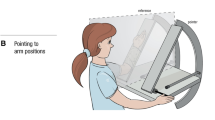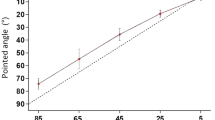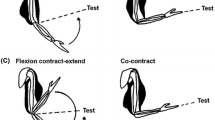Abstract
Position sense at the human elbow joint has traditionally been measured in blindfolded subjects using a forearm matching task. Here we compare position errors in a matching task with errors generated when the subject uses a pointer to indicate the position of a hidden arm. Evidence from muscle vibration during forearm matching supports a role for muscle spindles in position sense. We have recently shown using vibration, as well as muscle conditioning, which takes advantage of muscle’s thixotropic property, that position errors generated in a forearm pointing task were not consistent with a role by muscle spindles. In the present study we have used a form of muscle conditioning, where elbow muscles are co-contracted at the test angle, to further explore differences in position sense measured by matching and pointing. For fourteen subjects, in a matching task where the reference arm had elbow flexor and extensor muscles contracted at the test angle and the indicator arm had its flexors conditioned at 90°, matching errors lay in the direction of flexion by 6.2°. After the same conditioning of the reference arm and extension conditioning of the indicator at 0°, matching errors lay in the direction of extension (5.7°). These errors were consistent with predictions based on a role by muscle spindles in determining forearm matching outcomes. In the pointing task subjects moved a pointer to align it with the perceived position of the hidden arm. After conditioning of the reference arm as before, pointing errors all lay in a more extended direction than the actual position of the arm by 2.9°–7.3°, a distribution not consistent with a role by muscle spindles. We propose that in pointing muscle spindles do not play the major role in signalling limb position that they do in matching, but that other sources of sensory input should be given consideration, including afferents from skin and joint.



Similar content being viewed by others
References
Allen TJ, Proske U (2006) Effect of muscle fatigue on the sense of limb position and movement. Exp Brain Res 170:30–38
Allen TJ, Ansems GE, Proske U (2007) Effects of muscle conditioning on position sense at the human forearm during loading or fatigue of elbow flexors and the role of the sense of effort. J Physiol 580(2):423–434
Bock O, Pipereit K, Mierau A (2007) A method to reversibly degrade proprioceptive feedback in research on human motor control. J Neurosci Methods 160(2):246–250
Boisgontier MP, Nougier V (2013) Proprioception: bilateral inputs first. Neurosci Lett 534:96–100
Brown MC, Engberg I, Matthews PB (1967) Fusimotor stimulation and the dynamic sensitivity of the secondary ending of the muscle spindle. J Physiol 189(3):545–550
Brun C, Guerraz M (2015) Anchoring the “floating arm”: use of proprioceptive and mirror visual feedback from one arm to control involuntary displacement of the other arm. Neuroscience 310:268–278
Clark FJ, Burgess RC, Chapin JW, Lipscomb WT (1985) Role of intramuscular receptors in the awareness of limb position. J Neurophysiol 54(6):1529–1540
Collins DF, Prochazka A (1996) Movement illusions evoked by ensemble cutaneous input from the dorsum of the human hand. J Physiol 496(Pt 3):857–871
Collins DF, Refshauge KM, Todd G, Gandevia SC (2005) Cutaneous receptors contribute to kinesthesia at the index finger, elbow, and knee. J Neurophysiol 94(3):1699–1706
Ferrell WR, Smith A (1988) Position sense at the proximal interphalangeal joint of the human index finger. J Physiol 399:49–61
Fuentes CT, Bastian AJ (2010) Where is your arm? Variations in proprioception across space and tasks. J Neurophysiol 103(1):164–171
Gilhodes JC, Roll JP, Tardy-Gervet MF (1986) Perceptual and motor effects of agonist–antagonist muscle vibration in man. Exp Brain Res 61(2):395–402
Givoni NJ, Pham T, Allen TJ, Proske U (2007) The effect of quadriceps muscle fatigue on position matching at the knee. J Physiol 584(1):111–119
Goble DJ, Lewis CA, Brown SH (2006) Upper limb asymmetries in the utilization of proprioceptive feedback. Exp Brain Res 168(1–2):307–311
Goble DJ, Coxon JP, Wenderoth N, Van Impe A, Swinnen SP (2009) Proprioceptive sensibility in the elderly: degeneration, functional consequences and plastic-adaptive processes. Neurosci Biobehav Rev 33(3):271–278
Goodwin GM, McCloskey DI, Matthews PB (1972) The contribution of muscle afferents to kinaesthesia shown by vibration induced illusions of movement and by the effects of paralysing joint afferents. Brain 95(4):705–748
Gooey K, Bradfield O, Talbot J, Morgan DL, Proske U (2000) Effects of body orientation, load and vibration on sensing movement and position at the human elbow joint. Exp Brain Res 133:340–348
Gregory JE, Morgan DL, Proske U (1988) Aftereffects in the responses of cat muscle spindles and errors of limb position sense in man. J Neurophysiol 59(4):1220–1230
Hakuta N, Izumizaki M, Kigawa K, Murai N, Atsumi T, Homma I (2014) Proprioceptive illusions created by vibration of one arm are altered by vibrating the other arm. Exp Brain Res 232(7):2197–2206
Izumizaki M, Tsuge M, Akai L, Proske U, Homma I (2010) The illusion of changed position and movement from vibrating one arm is altered by vision or movement of the other arm. J Physiol 588(15):2789–2800
Kammers MPM, van der Ham IJM, Dijkerman HC (2006) Dissociating body representations in healthy individuals: differential effects of a kinaesthetic illusion on perception and action. Neuropsychologia 44:2430–2436
Kigawa K, Izumizaki M, Tsukada S, Hakuta N (2015) Proprioceptive interaction between the two arms in a single-arm pointing task. PLoS ONE 10(8):e0137031
Longo MR (2014) The effects of immediate vision on implicit hand maps. Exp Brain Res 232(4):1241–1247
Longo MR, Azanon E, Haggard P (2010) More than skin deep: body representation beyond primary somatosensory cortex. Neuropsychologia 48(3):655–668
Matthews PBC (1988) Proprioceptors and their contribution to somatosensory mapping: complex messages require complex processing. Can J Physiol Pharmcol 66:430–438
McCloskey DI (1973) Differences between the sense of movement and position shown by the effects of loading and vibration of muscles in man. Brain Res 61:119–131
Miller LE, Longo MR, Saygin AP (2016) Mental body representations retain homuncular shape distortions: evidence from Weber’s illusion. Conscious Cogn 40:17–25
Proske U, Gandevia SC (2012) The proprioceptive senses: their roles in signaling body shape, body position and movement, and muscle force. Physiol Rev 92(4):1651–1697
Proske U, Morgan DL, Gregory JE (1992) Muscle history dependence of responses to stretch of primary and secondary endings of cat soleus muscle spindles. J Physiol 445:81–95
Proske U, Morgan DL, Gregory JE (1993) Thixotropy in skeletal muscle and in muscle spindles: a review. Prog Neurobiol 41(6):705–721
Proske U, Tsay A, Allen T (2014) Muscle thixotropy as a tool in the study of proprioception. Exp Brain Res 232(11):3397–3412
Roll JP, Vedel JP, Ribot E (1989) Alteration of proprioceptive messages induced by tendon vibration in man: a microneurographic study. Exp Brain Res 76(1):213–222
Tsay A, Savage G, Allen TJ, Proske U (2014) Limb position sense, proprioceptive drift and muscle thixotropy at the human elbow joint. J Physiol 592(Pt 12):2679–2694
Tsay A, Allen TJ, Proske U (2015) Position sense at the human forearm after conditioning elbow muscles with isometric contractions. Exp Brain Res 233(9):2635–2643
Tsay A, Giummarra M, Allen TJ, Proske U (2016) The sensory origins of human position sense. J Physiol 594(4):1037–1049
Tsuge M, Izumizaki M, Kigawa K, Atsumi T, Homma I (2012) Interaction between vibration-evoked proprioceptive illusions and mirror-evoked visual illusions in an arm-matching task. Exp Brain Res 223(4):541–551
Velay JL, Roll J, Paillard J (1989) Elbow position sense in man: contrasting results in matching and pointing. Hum Mov Sci 8:177–193
Walsh LD, Proske U, Allen TJ, Gandevia SC (2013) The contribution of motor commands to position sense differs between elbow and wrist. J Physiol 591(Pt 23):6103–6114
White O, Proske U (2009) Illusions of forearm displacement during vibration of elbow muscles in humans. Exp Brain Res 192(1):113–120
Author information
Authors and Affiliations
Corresponding author
Rights and permissions
About this article
Cite this article
Tsay, A., Allen, T.J. & Proske, U. Position sense at the human elbow joint measured by arm matching or pointing. Exp Brain Res 234, 2787–2798 (2016). https://doi.org/10.1007/s00221-016-4680-y
Received:
Accepted:
Published:
Issue Date:
DOI: https://doi.org/10.1007/s00221-016-4680-y




